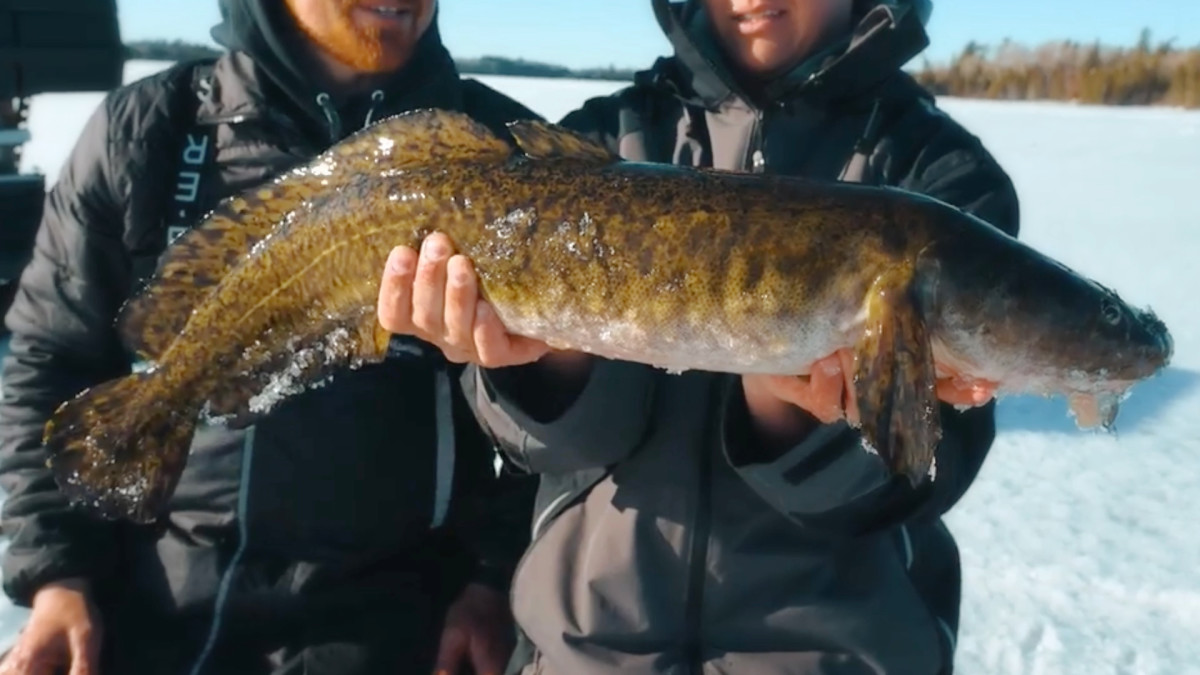
Also known as the eelpout, lingcod, and cusk, burbot are an aggressive and populous freshwater fish found in lakes and rivers across the northern United States and Canada. Often described as a cross between a catfish and an eel, these freshwater members of the cod family were once thought of as trash fish by most anglers. Yet, in the past few years, the burbot’s availability and edibility during the winter has led to a change of attitude that has seen the burbot rise to the top of many ice angler’s bucket lists.
During the summer, burbot tend to be scarce and spend much of their time hiding in deep water and only feeding at night. In winter, the fish become much more active and can be caught throughout the day at varied depths and on an assortment of lures. Their unpredictable nature is very much a part of their appeal. Some ice anglers have fantastic burbot days in shallow water while targeting perch and panfish. Others catch them consistently on deep water rigs while targeting lake trout. However, if you actually want to target and catch burbot, your best bet it to fish for them during their deep winter spawn.
From January to March, the constantly roaming and ever-mysterious burbot begin to adopt a more standard behavior that makes them vulnerable to anglers. The fish will push out of their deep-water haunts and begin to gather in and around shallow-water rock shelves and flat sandy shoals that are immediately adjacent to deeper water. Here, the fish will either be making forays into the shallow water to feed between spawning sessions, or they will be patrolling the water and attacking anything they feel may be a threat to their spawning grounds.
Though little is known about their spawning behavior as it changes from waterbody to waterbody, this movement into shallow water for the spawn is consistent throughout their range, from Alaska to the Great Lakes. During this window, you can target the fish in eight to ten feet of water and have some completely lights-out fishing—so long as you’re using the right bait and equipment.
Best Winter Burbot Bait and Equipment
Burbot are surprisingly hard fighters and can grow to some massive sizes with the current world record being 25 pounds. So whether you’re jigging, dead sticking, or using tip-ups, it’s vital to fish with lines heavy enough to handle the job.
“I never use anything below 10-pound test when fishing for burbot,” ice fishing guide and burbot junkie James Mugele said. “They pull hard and can really put a bend in your stick or burn up your fingers on a tip-up line. In most places I fish for them, the water is pretty clear, and the fish can be leader shy, so I’ll usually add a length of heavy 12- to 20-pound fluorocarbon to my rig as a leader.”
Mugele sets up his burbot rigs by tying a small barrel swivel to the main line of his jigging rod or tip-up and then adding two to four feet of fluorocarbon to the other side.
“Using the swivel instead of tying everything straight to the line is super necessary,” Mugele told MeatEater. “It gives you a marker for depth and a stopper for your split shot so they don’t slide all the way down the line, but mostly, it just makes everything easier to tie on and set up with cold fingers.”
In addition to heavy line, anglers jigging or dead sticking for burbot will want a slightly stiffer jigging rod. This not only helps with handling the heavy, hard-fighting fish but also helps you have better control of the often extremely large lures and baits you’ll be using to catch the fish. These can include heavy jigging spoons like the RealImage and the Bomber, heavy ¼- to ¾-ounce bucktail jigs, or even large soft plastic jigs like Johnson’s Paddletail. For the best results, tip your jigs with chunks of cut bait or even live minnows which will struggle and flash, drawing in hungry burbot and triggering them to attack.
Burbot are scavengers and aggressive predators, so you can have a lot of luck using both live and dead bait. The best of these baits are small- to medium-sized gold shiners between three and five inches long or large chunks of cut bait from either a sucker (burbot's most common prey) or a recently caught panfish so long as it’s legal to do in the water that you’re fishing.
While electronics aren’t entirely necessary for burbot fishing, they can be extremely helpful. Unlike perch and panfish, which travel in large schools, burbot often travel alone or in pairs, making the fish difficult to find. Additionally, they often become quite sedentary during the day and won’t move more than a few feet from one spot or another. Electronics can be extremely helpful in these situations as they allow you to search the water for active fish and can help you pinpoint exactly where dormant burbot may be lying so you can drop your lures right down on top of their heads.
Winter Burbot Tactics
Setting up for burbot during deep winter is all about the shallows. Those small sandy flats and rocky points that rise up out of deep water are going to be patrolled by and hold most of the burbot. As previously mentioned, the best spots are usually in eight to ten feet of water in areas immediately adjacent to deep drop-offs. To be successful in these areas, you’ve got to cover water by drilling several holes between five and ten yards apart so that you can jig or set up tip-ups until you find a consistent bite.
“I usually set up in a grid pattern,” Mugele said. “I’ll drill a line of holes—four or five holes straight away from me that runs along the center of a sand flat or runs along the edge of a drop-off. Then I’ll drill two or three holes to the left and right of that line, so I’ve got almost everything covered. Then, when I’m jigging, I can hit each hole for 20 minutes to an hour, going up and down the line, and I’ll set up my tip-ups on the corners and in the center. It’s usually a pretty productive set-up.”
When blind jigging for burbot without electronics, it's best to be aggressive. Drop your jig to the bottom repeatedly so that it clacks off rocks and stirs up sand. Then, lift it two to three feet and suspend it for a few seconds. Often fish that are attracted to the erratic movement will follow the jig higher into the water column and only strike once it stops moving. This is especially true when targeting post-spawn fish, which can be extremely aggressive.
“Unless I can watch how the fish are acting and reacting to my bait on my Livescope, I always jig pretty aggressively,” Mugele told MeatEater. “Most of the time, they’ll either strike it or at least swipe it when it’s bobbing on the bottom and then inhale it when it starts to move to the surface, so holding it off the bottom for a few seconds after each jigging session is vital.”
Tip-ups can be really productive for burbot fishing so long as they are set up correctly and placed in the right spots. Start by adding a two- to four-foot length of leader to your main line and then tie on a size 4 to size 2 circle hook. Add a couple of small spit shot to the rig and then your bait. Hook live baits through the top of the back below the dorsal fin and dead baits through the tail. Burbot tend to eat baits headfirst, so hooking your bait this way will both ensure that the fish won’t feel the hook point and drop it and will prevent the burbot from swallowing the bait should you want to release it.
Set your tips-ups by dropping the baits to the bottom and then tightening the line slightly so that they will hang suspended a few inches from the rocks and the sand. Burbot are ambush predators who lie in structure, waiting for prey to swim past their jaws. Therefore, it’s best to set up your tip-ups as tight to cover as you can, paying particular attention and even setting up multiple lines in any areas with a lot of sudden drop-offs or rock piles as these are ideal places for burbot to burst out of hiding and engulf your baits.
Becoming a Cod Artist
I brought my first burbot home, and after finding a quick how-to instruction manual in one of my books, I managed to clean it. I was apprehensive about eating the mottled brown, snapping-jawed fish that looked like a combination of a bullhead and an orc from Lord of The Rings. Yet, once I fried the meat and had my first bite of that deliciously flaky flesh, my entire view changed.
Burbot are the very definition of contrast. With piggy eyes and a long, slimy body, there’s almost an instinctive repulsiveness to touching them. Yet beneath their mud-colored skin is a pile of white meat that can be used for just about anything from fish fries and chowders to Poor Man’s Lobster Rolls. In addition, burbot tend to live in wild, beautiful, and out of the way places that make ice fishing for them a true adventure.
To be a burbot angler is to be part of a beautiful circle where you travel to a pristine and picturesque piece of ice to catch a horribly ugly fish, which you’ll either bring home for an exquisite meal or release to ensure that burbot will always be there to help us all get through the hardest days of winter.
Want to see more ice fishing for burbot? Check out this episode of The Canadian Angle.






Conversation